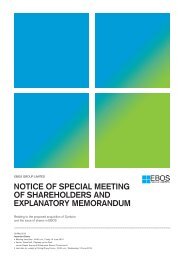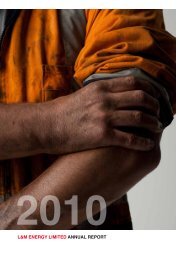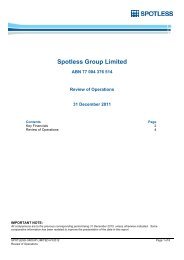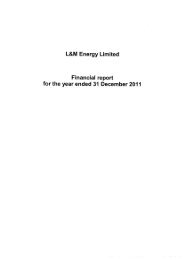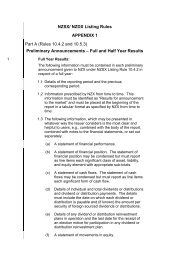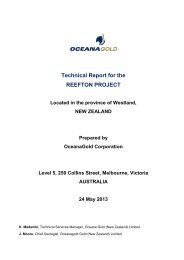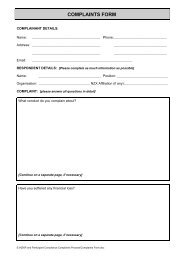Westpac Group Pillar 3 Report March 2013 - Iguana IR Sites
Westpac Group Pillar 3 Report March 2013 - Iguana IR Sites
Westpac Group Pillar 3 Report March 2013 - Iguana IR Sites
Create successful ePaper yourself
Turn your PDF publications into a flip-book with our unique Google optimized e-Paper software.
PILLAR 3 REPORT<br />
GROUP STRUCTURE<br />
<strong>Westpac</strong> New Zealand Limited<br />
<strong>Westpac</strong> New Zealand Limited (WNZL), a wholly owned subsidiary entity 1 , is a registered bank incorporated in<br />
New Zealand and regulated by the Reserve Bank of New Zealand. WNZL uses the Advanced <strong>IR</strong>B approach for<br />
credit risk and the Advanced Measurement Approach for operational risk. For the purposes of determining<br />
<strong>Westpac</strong>’s capital adequacy, <strong>Westpac</strong> New Zealand Limited is consolidated at Level 2.<br />
Restrictions and major impediments on the transfer of funds or regulatory capital within the<br />
<strong>Group</strong><br />
Minimum capital (‘thin capitalisation’) rules<br />
Tax legislation in most jurisdictions in which the <strong>Group</strong> operates (including Australia, New Zealand and the United<br />
Kingdom) prescribes minimum levels of capital that must be retained in that jurisdiction to avoid a portion of the<br />
interest costs incurred in the jurisdiction ceasing to be tax deductible. Capital for these purposes includes both<br />
contributed capital and non-distributed retained earnings. <strong>Westpac</strong> seeks to maintain sufficient capital/retained<br />
earnings to comply with these rules.<br />
Tax costs associated with repatriation<br />
Repatriation of retained earnings (and capital) may result in tax being payable in either the jurisdiction from which<br />
the repatriation occurs or Australia on receipt of the relevant amounts. This cost would reduce the amount actually<br />
repatriated.<br />
Intra-group exposure limits<br />
Exposures to related entities are managed within the prudential limits prescribed by APRA in APS222 Associations<br />
with Related Entities 2 . <strong>Westpac</strong> has an internal limit structure and approval process governing credit exposures to<br />
related entities. This structure and approval process, combined with APRA’s prudential limits, is designed to<br />
reduce the potential for unacceptable contagion risk.<br />
Prudential regulation of subsidiary entities<br />
Certain subsidiary banking and insurance entities are subject to local prudential regulation in their own right,<br />
including capital adequacy requirements and investment or intra-group exposure limits. <strong>Westpac</strong> seeks to ensure<br />
that its subsidiary entities are adequately capitalised and adhere to regulatory limits at all times. There are no<br />
capital deficiencies in subsidiary entities excluded from the regulatory consolidation at Level 2.<br />
1 Other subsidiary banking entities in the <strong>Group</strong> include <strong>Westpac</strong> Bank of Tonga, <strong>Westpac</strong> Bank-PNG-Limited, <strong>Westpac</strong> Bank Samoa Limited and <strong>Westpac</strong><br />
Europe Limited.<br />
2 For the purposes of APS222, subsidiaries controlled by <strong>Westpac</strong>, other than subsidiaries that form part of the ELE, represent ‘related entities’. Prudential<br />
limits apply to intra-group exposures between the ELE and related entities, both on an individual and aggregate basis.<br />
13



